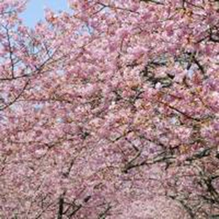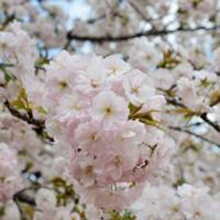Posted on The Japan Times by Reiji Yoshida, Staff Writer, Mar 14, 2016
http://www.japantimes.co.jp/news/2016/03/14/reference/the-centuries-old-charm-of-japans-cherry-blossoms/#.VvjBu3py4qs
The time of year much awaited by many people across the country is finally near: the blooming period of the nation’s beloved sakura (cherry blossoms).
Numerous people plan hanami (cherry-blossom viewing) under the trees, one of the biggest spring events on the Japanese calendar.
But when did people first start cherishing sakura? And when and how did they start gathering for viewing parties under the trees?
Following are questions and answers about sakura and hanami:
What does hanami mean?
Hana literally means “flowers” in Japanese, and mi means “viewing.”
But when the two terms are combined, it usually means cherry-blossom viewing, indicating cherry blossoms have been adored for centuries.
Until the Nara Period (710-794), the nation’s most favorite flower was ume (Japanese apricot), most likely because of a strong cultural influence at that time from China, where ume originated.
But in the Heian Period (794-1185), sakura became more popular among Japanese aristocrats.
Many experts link this transition to the 894 abolition of Kentoshi, Japan’s official delegations to China. The abolition cut off Japan from Chinese influence and helped people cultivate their own culture based on the local climate and nature, they say.
After the mid-Heian Period, “the flower” mentioned in poems usually referred to sakura, even if it wasn’t stated explicitly, according to Yozaburo Shirahata, professor of comparative culture studies at Chubu University who published the book “Hanami to Sakura” (“Hanami and Cherry Blossoms”) in 2000.
Did the Heian Period have hanami parties similar to now?
 No. During the Heian Period, hanami was an elegant custom among the well-educated aristocracy only and did not involve crowds eating and drinking under cherry trees.
No. During the Heian Period, hanami was an elegant custom among the well-educated aristocracy only and did not involve crowds eating and drinking under cherry trees.
In 1598, the warlord Toyotomi Hideyoshi held an extravagant hamani party at Daigoji Temple in Kyoto for feudal lords and their followers, but the practice had yet to spread to the common people.
According to Shirahata, today’s hanami parties are characterized by three elements: crowds, food and drinks, and a large number of sakura trees.
Today’s hanami parties trace their roots to after the mid-1600s in Edo, today’s Tokyo. One of the earliest hanami venues was Ueno of today’s Taito Ward, which is still a very popular place with numerous sakura trees.
How did hanami become popular with nonaristocrats?
During the Edo Period (1603-1868), Japan enjoyed freedom from warfare at home and abroad for more than two centuries. This allowed common people, in particular those living in Edo, to nurture a rich culture of their own. Edo was the capital of the Tokugawa shogunate.
Tokugawa Yoshimune (1684-1751), the eighth shogun, planted numerous sakura trees and created several hanami venues in Edo for common people to enjoy. This, too, greatly helped spread the hanami practice among the public, Shirahata wrote in his book.
Among the Edo hanami sites Yoshimune created were those in Asukayama, Mukojima, Gotenyama and Koganei. Some of those places are still among the most popular hanami spots in Tokyo today.
Are we seeing descendants of the Edo Period cherry trees?
Probably not. Until the end of the Edo Period, people viewed various cherry blossom varieties, including yamazakura, edohigan and kanhizakura.
But after the someiyoshino hybrid was artificially created, probably in the late Edo Period or early Meiji Era (1868-1912), the variety has become extremely popular in Japan thanks to its beautiful, slightly-pinkish blossoms.
Someiyoshino now probably accounts for 70 to 80 percent of all sakura trees in Japan, according to Toshiki Sato, professor at the University of Tokyo who published the book “Sakura ga Tsukutta Nippon” (“A Japan Created by Cherry Blossoms”) in 2005.
All someiyoshino trees are planted using a technique called tsugiki (grafting). This means all existing someiyoshino trees have identical DNA, the exact reason most sakura in Japan blossom, then subsequently fall, almost simultaneously.
This synchronization makes the scenery of cherry blossoms even more stunning, probably another reason someiyoshino are dominant in Japan.
When can we see sakura in Tokyo and elsewhere this year?
According to the “cherry-blossom front” forecast released by the Japan Weather Association on March 9, someiyoshino start blooming in Tokyo’s Chiyoda Ward on March 21, and will be in full bloom about a week later.
Elsewhere, the cities of Fukuoka and Nagoya will see the first blooms on March 22, Yokohama on March 23, and Osaka, Kyoto, Nara and Kobe on March 25.
Hirosaki of Aomori Prefecture, known for beautiful cherry trees in Hirosaki Park, will see this year’s first bloom of someiyoshino on April 20, with blooms in Sapporo expected on May 2.
Original Article: The centuries-old charm of Japan’s cherry blossoms on The Japan Times @ http://www.japantimes.co.jp/news/2016/03/14/reference/the-centuries-old-charm-of-japans-cherry-blossoms/#.VvjBu3py4qs

